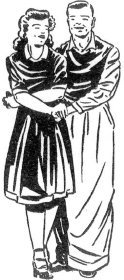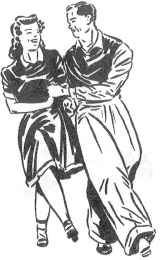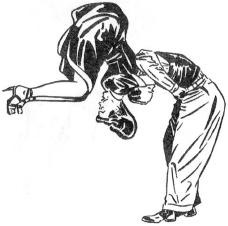The Swing Book (14 page)
Authors: Degen Pener

There are a number of fun, well-known moves that don’t fall into any category, except that they aren’t done in breakaway but in close pairings. There’s the cuddle, in which the leader brings the follower back from a swingout, snuggling her up against his body, putting his right hand around her back on her right hip and his left hand holding her right hand in front of her body. You’ve probably seen people do the popular pretzel, in which both partner’s loop and unloop their arms over their shoulders as they turn. Best of all is the mess around, which sounds as erotic as it feels. For this move, both partners hold their hips close together and move in unison around in a circle, marking beats as if pausing along the numbers of a clock.

Cuddle
Since the Charleston was one of the progenitors of the Lindy, it’s perfectly natural to add its moves to your swing dancing. The most recognizable step is called the tandem or back Charleston. “The girl is in front of the guy and they are holding hands and facing in the same direction,” says Louise Thwaite, a Lindy Hopper with expertise in the Charleston. “They kick and touch the toe forward with the same leg, come back to the center and then kick back and touch the toe behind, or they can do a kick with a hop for a more energetic move.” Other moves are known as the Flying Charleston (“you’ll pass by each other quickly as you are doing basic Charleston kicks,” says Steve Conrad), side Charleston, crossover Charleston, and hand-to-hand Charleston (in which the partners are facing). The dance, which originated in Charleston, South Carolina, was popularized in an all-black Broadway show,
Running Wild,
in 1923, which included the song “Charleston” by Harlem stride pianist James P. Johnson. “In the 1920s it was the biggest dance craze the world had ever seen, and the only one that was bigger was the Lindy,” says Thwaite. While it was considered a scandal in its day (the risqué Josephine Baker was one of the most famous Charleston dancers), it’s now a way of adding a distinctly twenties look to your Lindy.

Charleston Kick
Aerials, or air steps, as they are known because they are danced in time to the music, are the extreme sport of swing. They were invented by Frankie Manning back at the Savoy around 1936. Today they are perhaps the most well-known moves associated with swing, thanks to that Gap commercial. Wild, crazy, thrilling, and high-flying, they put the zing in swing. “When people first see swing the thing that grabs their attention is the aerials,” says Tammy Finocchiaro of Ventura, California’s aerials troupe the Flyin’ Lindy Hoppers.
But air steps aren’t for everyone. If you’re a beginner, it will be some time before you’re proficient enough to start learning them. “A lot of young kids say, ‘Oh, how do you do the air step?’” says Manning. “I say, ‘How long have you been dancing? Three weeks? You know I started dancing in 1927, the first air step was done eight years later, so I had a long time to learn how to dance before the air step was even created.’”
You may in fact never be able to do them. “If you are not athletically inclined, if you do not have a sense of timing and balance, you know, forget aerials, you’ll kill yourself,” says Iannucci. Adds Sylvia Skylar, “There are some people who just never feel comfortable in the air. They hate being upside down.”

Aerial
Aerials can be dangerous. Finocchiaro and her partner, Lee Moore, have each broken their noses doing them. To be safe, aerials should be learned from trained teachers using spotters or mats or both.
Finally, air steps should never be done in a social dance situation but only during jam sessions, contests, and performances. It’s too easy for people to get hurt on a packed dance floor if someone attempts an aerial. Even at the Savoy, they were only performed in a cordoned area of the ballroom.
Don’t be scared off, however. Aerials, when performed properly, are as thrilling as the best roller-coaster ride. “You get to fly,” says Finocchiaro, whose group has created an amazing step in which one guy throws her over another guy’s head. When you’re learning, though, you’ll start with somewhat less spectacular moves. Some of the most accessible steps include the side car, in which the woman has her legs together and swings from left to right facing her partner, and the lamppost, also known as over the back or the helicopter. “You bring the girl and hook her over your arm and send her over your back,” says Sylvia Skylar. “It’s the most common aerial.” While it’s fun to know which moves, such as the lamppost, were originally done at the Savoy, astounding new aerials are being created all the time too. “I do an aerial where I go fifteen feet up in the air and then I come back down head first in between my partner’s legs. They call it the big dive,” says champion dancer and aerial specialist Nathalie Gomes. (Again, please don’t try these at home.)
So how do you do a good aerial? Work on the timing between yourself and your partner. Work on it again and again. Accidents happen when you’re doing something the other person thought was going to happen five seconds before. Discuss beforehand which step you plan to accomplish. Leaders should work on getting the right grip on their partner. “Grab the hip bone. If you grab her body and it goes squish, you are in the wrong location,” says the Flyin’ Lindy Hoppers’ Moore. Once the follower is coming back down from her flight, the leader should be sure to grab her hips again and bend in his knees to cushion her fall. “You are not only there to lift her, you are there to babysit her and help her land,” says Gomes.
Most important, don’t hold back. Aerials work because of a perfectly synchronous interplay of leverage and momentum. When you hesitate, everything can be thrown off. Says Finocchiaro, “You have to go without any fear.” Let ’em rip.
So you know how to do the electric slide. But can you get out on the floor and do these group dances that are associated with the Lindy?
- T
HE
S
HIM
S
HAM
S
HIMMY
: It’s become a tradition for Frankie Manning to lead the Shim Sham Shimmy line dance wherever he’s teaching. Developed originally as a tap number, it was adopted by Lindy Hoppers in the early thirties. Everyone stays facing the same wall throughout the routine, as they move through steps that include stomps, boogie backs, and the Shorty George. The best part is when the leader says “Swing.” At that point you grab the nearest partner and dance the Lindy until the leader calls out “Stop.” Then freeze for eight beats until the leader declares it’s time to dance again. A great song for dancing the Shim Sham is Erskine Hawkins’s “Tuxedo Junction.” - T
HE
J
ITTERBUG
S
TROLL
: A more recent line dance, the Jitterbug Stroll was created by Ryan Francois to be danced to Woody Herman’s “Woodchopper’s Ball.” It puts together such exciting moves as boogie backs, the Suzy Q, and the Shorty George, with quarter turns between the different sections. By the end of the stroll, you will have faced all four walls. - T
HE
B
IG
A
PPLE
: Created in Columbia, South Carolina, around 1930, the Big Apple was once such a popular dance that there were hundreds of Big Apple clubs across the country. It requires a caller who stands in the center of a circle and shouts out a variety of moves, from Charleston to stomp off to truckin’. “It’s really fun actually, even if you don’t know what to do,” says Sharon Ashe. “Because everybody repeats each move for a few eight-counts, you can just look around and copy people.”
Swing dancing has been around for more than seventy years, and like any art form, it grows and changes all the time. With its resurgence in the 1990s, people now dance many different styles of the Lindy, often depending on the city or region in which they live. Indeed, even the original Savoy-style Lindy Hop had countless variations to it. “There is no true Savoy,” says Debra Sternberg. “There were thousands and thousands of people showing up at the Savoy Ballroom every night. Everybody didn’t dance the same way. The people who say there is one true authentic style are the ones who are teaching now who have to sell themselves.” Today the Lindy Hop includes Savoy, Dean Collins, and Hollywood styles. Plus, swing also begat a variety of other dances, including the shag, the Dallas Push in Texas, the Imperial Swing in Saint Louis, Florida’s Beach Bop, and a New Orleans Lindy variant called the Jamaica. Here’s a handy reference to the most well-known swing styles and related dances that are being practiced across the United States—and around the globe—all of them descendants of the Lindy Hop, which Norma Miller calls “the granddaddy” of them all.
In the mid-1930s, one-time Savoy dancer Dean Collins moved to Hollywood to dance in such movies as
Buck Privates
and
Ride ’Em Cowboy.
Whereas Frankie Manning exemplified the Savoy style of swing, with the man keeping himself low to the ground, like a runner at the start of a race, Collins held himself more upright when he danced. In the early 1980s, dance instructors Jonathan Bixby and Sylvia Sykes sought out Collins, who had since retired from dancing, and asked him to teach them his moves. They helped popularize Dean Collins’s smoother, more contained style among West Coast swingers.
Collins may have been the most well-known smooth-style dancer in the movies, but he wasn’t the only one. Recently, interest has been increasing in the styles of some of his jitterbugging colleagues, most notably Jean Veloz (who appears in the cult dance instruction film
Groovy Movie)
and Lenny Smith. A few years ago LA dance teachers Sylvia Skylar and Erik Robison, inspired by the many variations done by these film dancers, including Collins, trademarked a smooth Lindy as “Hollywood style.” They even tracked down Veloz at a local bar called Bobby McGee’s, where many old-timers hang out. Since then the dance has been a major hit in Los Angeles and Washington, D.C., with Lindy Hoppers in other cities catching on all the time. One of its distinctive marks is the whip, in which the leader sends the follower out with a very explosive action. “Ask a West Coaster to watch us and they’ll say we dance Lindy,” says Skylar. “Ask a Lindy Hopper and they’ll say we look West Coast.”
WCS was originally called Western swing, but the name was changed to avoid confusion with country-western swing. Some dance experts claim that WCS grew out of the smoother Dean Collins style; however, Collins claimed he had nothing to do with this variant, according to Sykes. WCS is actually more rigid than Collins’s style, with the couple dancing in a line or slot, which some dance historians believe developed as a response to California’s extremely crowded ballrooms. It is done in an upright position and the primary moves include a push, a pass, and a whip. Since the eighties West Coast has also incorporated many elements of the hustle. WCS can be done to smoother modern music, such as R&B and pop, and can be very sultry if danced properly.